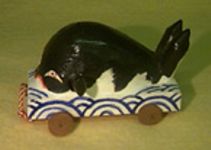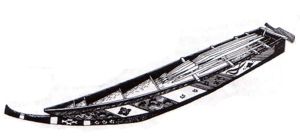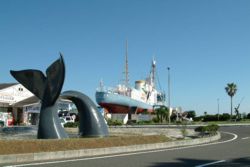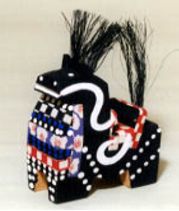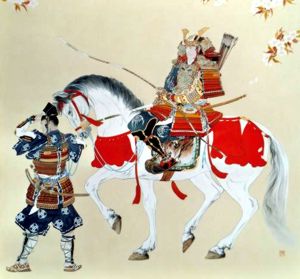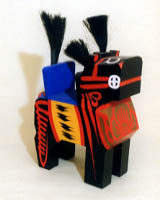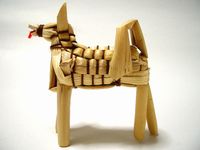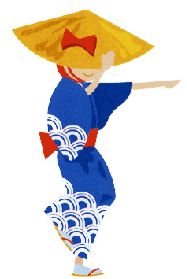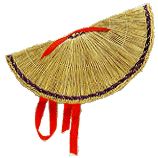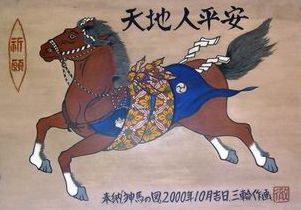WHALE
CART
This tradition began at the spot where one of the most famous Christian warlord clans -- Omura -- ruled: Nagasaki. A gigantic paper whale used to be wheeled around the streets of the city as a part of the harvest festival. Omura's people and their descendants were not whale hunters, but they did have something to do with whaling and processing the deep-sea harvest. You know the Japanese are among the few peoples to whom whale meat is food (see another page at this site for pictures of whale meat). But their technology was stagnant. The Japanese whaling boats never changed since a thousand years ago:
Such boats were 8 to 10 meters in width, and decorated colorfully. This boat has a history of its own. When the 'latter Hojo' clan of Odawara plunged itself and all its vassals into a hopeless war against Toyotomi Hideyoshi and Tokugawa Ieyasu in mid-1580's, a samurai from the losing side fled from the battlefield. His name was Asahina Yoshihide. He settled down in a village at Wakayama Prefecture, which at the time was some sort of a 'neutral' province. The village was called Taiji. Usually villagers were mercilessly cruel to losers of warlords' battles; they robbed and killed everybody fleeing to there whereabouts. But not this time. Asahina said he would lay down arms and let go of his samurai status. This was fisherfolks' village, so Asahina had no choice except to become a fisherman there. "But my ancestors were samurai," he said to the bewildered villagers. "So I will be one of you, but not to catch those little fishes! Let's catch the largest of all! Whales!" With his warlike enthusiasm, he made the first whaling boat himself, and set down rules for whale-hunting. Asahina also caused headaches all around -- the local smith couldn't catch up with his ideas of some special weapons for whaling, which Asahina, of course, only imagined because he never hunted whales all his life. But one fine day all the props were ready at last, and the first party of whalers set off. And they, according to the folktale, caught their first whale that same day. From then on, the village of Taiji became a whaling dock. Asahina designed more boats for a large-scale hunt, in which the first kind of boat acted as the harpooners'. So this ex-samurai is remembered until today as the father of the....er....anti-environmentalism. When Herman Melville wrote his Moby Dick in 1851, Japanese whalers hadn't yet make the biz an 'industry' in the sense of using 'advanced' tools. In Europe itself the notorious 'killer ship' was only invented in 1865 (by Svend Foyn). It wasn't, then, such ships that the overhyped John Manjiro worked his way to immortality on.
This man was an ordinary fisherman who got stranded at the Isle of Birds (Torishima) in 1841 and took refuge on an American steamer whose captain then employed him as a member of the crew. Manjiro sailed to Hawaii and then to America itself and back. Manjiro was sometimes depicted as if he did something heroic, but he was only notable because in his times Japan was still under the coccoon woven by Shogun Tokugawa Iemitsu in 1637 (no Japanese was allowed to leave the islands) and preserved by all his successors since until the arrival of Commodore Matthew Perry in 1852, a year after Kawada Shoryo released his woodblock prints depicting John Manjiro's adventure. Small wooden whales on carts have been made as charms for whalers, and miniatures of Asahina's original whaling boats have been, too.
ARCHERS' HORSE
Since Tokugawa Ieyasu died in 1616, no interclan war was big enough to distract the Tokugawa clan from their distractions. One of which was a contest of archery on horseback that became a tradition until today, 'yabusame' (click here for story and pictures). It gave the idle samurai of the long Tokugawa reign some fake sense of belonging to the great history of the class (the original Japanese samurai were mounted archers). The contest used to be held at the shrine of the Shinto God of War, Hachiman ('Yawata Hachimangu'), on August 15th every year. That's why the 'Yawata horses' got their 'primitive' look -- they are deliberately made so, with just an axe and a few basic colors, usually red and black. The 'native' horses of Japan were too small and too slow to go to war on. War horses were sort of 'imported' from places that were still seen as edges of the Empire of Japan in 16th century, such as Hokkaido, and the territory of the Nanbu clan. The imported horses were the Ainu tribes'. These horses were weapons. They were tall, sturdy, violent; Oda Nobunaga's horse Tsukinowake (click here for pictures and story) was reportedly as fierce as the rider in battles and killed just as many enemies as Oda himself did.
That's why you always see a Japanese samurai in all his regalia perching on his horse while incongruously an attendant is depicted as holding the reign at the same time in anciet scrolls and 'modern' prints alike. When a warlord was surveying the battlefield before riding in, or when he delivered a speech in front of his soldiers before marching to war, he wouldn't be able to hold the horse still for long without any help -- not even Oda Nobunaga, who was attached to his horses and they were to him. The Yawata horse was supposed to be a charm of the pseudo-cavaliers of the effeminate hundreds of years between 1616 and 1868, and it was inevitably made as mere souvenirs since the americanized Meiji era. |
HEIAN
HORSE
This charm has some magic attached to its history. In 799, there was a small outlaying castle of the Japanese Empire at Miharu, today's Fukushima Prefecture. Functioned as a buffer to shield the empire from Ainu tribes, this borderline castle was regularly at war. That year it couldn't really hold on under the constant attack of the Ainus, so messengers galloped to the newly-built capital city of Kyoto and begged Emperor Kuammu to send some reinforcement or else they would lose the castle. The Emperor gave his mandate to normalize situation at the border to General Sakanoue Tamuramaru. General Sakanoue wasn't really sure of his troops' chance. So he, when as custom required dropping by at the Kiyomizu temple to pray for victory, earnestly asked Buddha whether his prospect was good enough or not, though it wouldn't, of course, change anything since he still had to march to the frontier even if only to perish. The Kiyomizudera's Abbot Enchin sensed the General's anxiety. At the time, Enchin was very busy carving a large statue of Buddha. He quickly made small toy-like horses from the same wood, 100 pieces in all. They look like the Yawata horses -- war horses complete with saddles and reigns and accessories. "It's just some farewell gift, General," he said to Sakanoue. The General thanked him and put the horses into his empty box of armor. Sakanoue's fear materialized at the border. The army he led was beaten so badly by the Ainus until he started to think they'd never be able to get back. Suddenly there were 100 most violent battle-horses appeared from nowhere, and whoever rode them was able to reverse the tide of the battle. In short, Sakanoue's army won. But one of the horses was wounded and galloped away. When the exhausted but elated Sakanoue had a chance to rest, he opened his armor box and only 99 wooden horses were found there. The wooden horses Enchin gave him had won the war for the army. A local artisan of Miharu copied Enchin's wooden horses to replace the 100th horse. Since then, all samurai under Sakanoue's command and those stationed at Miharu carry one wooden horse everywhere, especially to battlefields. In today's Niigata Prefecture, the same horse has been made the same way as Japanese household broom, from natural fibers, like the picture below, and is called
OKESA GOMA
Okesa is also famous for its distinctive hats, originally worn by the local dancers, called
OKESAGASA
Click
here for BIG pictures of
PRAYER TABLET HORSE
The word for 'horse' in Chinese is 'ma'. The Japanese imported it along with the Chinese script in 6th century. 'Ema' means 'picture of a horse'. Votive plaques like in the pic above are characteristic of Shinto shrines. The ones with horses on them are said to have been invented during the reign of Emperor Suinin (29 before Christ, until the year 70). Why horses for shrines and temples? (btw, click here if you have no idea of the total difference between the two) Because the Shintoists believe that gods ride horses -- which is a very logical faith (paradoxical, like all things Japanese), since Shintoism is about ancestral worship, and the ancestors of the Japanese were samurai, and these samurai were cavaliers. Since 660 BCE until Emperor Suinin ascended, warriors and noblepersons used to give offerings in the form of live horses -- which were to be kept around shrines and gave much trouble to the Shinto priests who never had any use for them (and these were war-horses, too, that couldn't be told to work or rode by civilians!) The most commonsensical Emperor of his days, Suinin stopped this impractical and cumbersome offering. He substituted it with images of horses. Only on spectacular victories and such were live horses to be delivered to shrines since, like, when Oda Nobunaga had just won his Okehazama battle in June 1560. Because of Emperor Suinin's decision, today all sorts of prayer tablets are called 'ema', regardless of what picture is painted on them. Click here for BIG pictures of the varieties of Japanese prayer tablets.
|
| Previous | Next |
PAGES OF LITTLE-KNOWN JAPANESE FACTS & LITTLE THINGS ABOUT JAPANESE SAMURAI
| 01 | 02 | 03 | 04 | 05 | 06 | 07 | 08 | 09 | 10 | 11 | 12 | 13 | 14 | 15 | 16 | 17 | 18 | 19 | 20 |
| 21 | 22 | 23 | 24 | 25 | 26 | 27 | 28 | 29 | 30 | 31 | 32 | 33 | 34 | 35 | 36 | 37 | 38 | 39 | 40 |
| 41 | 42 | 43 | 44 | 45 | 46 | 47 | 48 | 49 | 50 | 51 | 52 | 53 | 54 | 55 | 56 | 57 | 58 | 59 | 60 |
|
Site & Rap © 1996, 1997, 1998, 1999, 2000, 2001, 2002, 2003, 2004, 2005, 2006 Nina Wilhemina
Pictures for this section
are compiled by Obata Sugizo, Ryoku Nakane, Hasegawa Tomoko, Asada Kanae,
Matt Emery, Arisugawa Takashi, Sandy McClelland, James Kwan, Richard Rock,
Mary B. Morton, and Zui Rena
All rights reserved. Every borrowed image at this site is put for non-profit educational purposes only.
HOME
 LINKS
LINKS
 CONTACT
CONTACT
 CREDITS
CREDITS
 COMMENTS
COMMENTS
